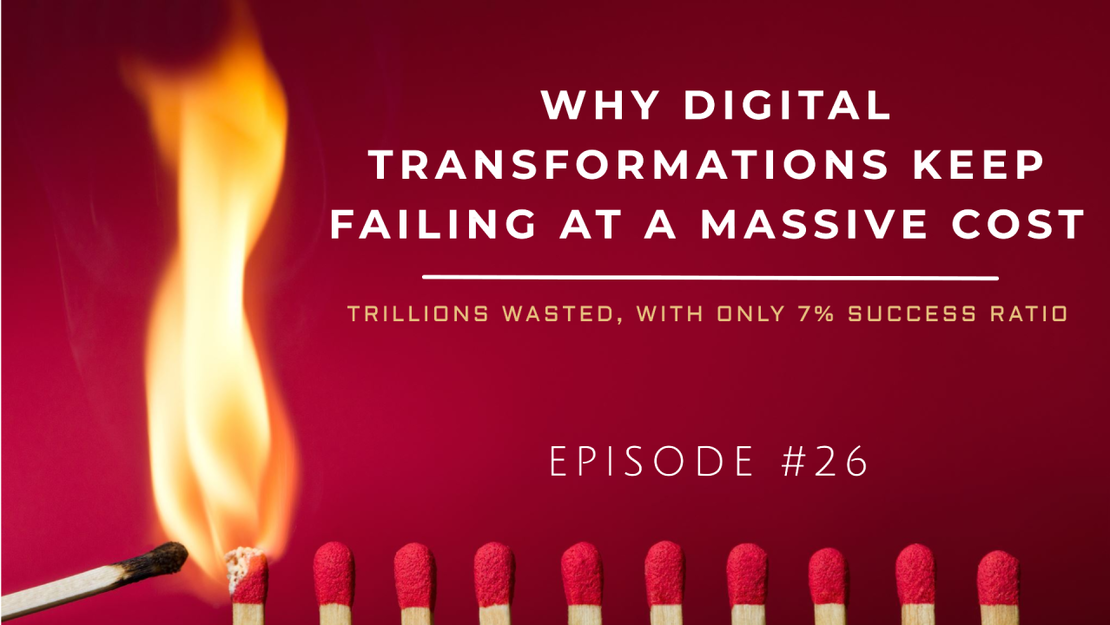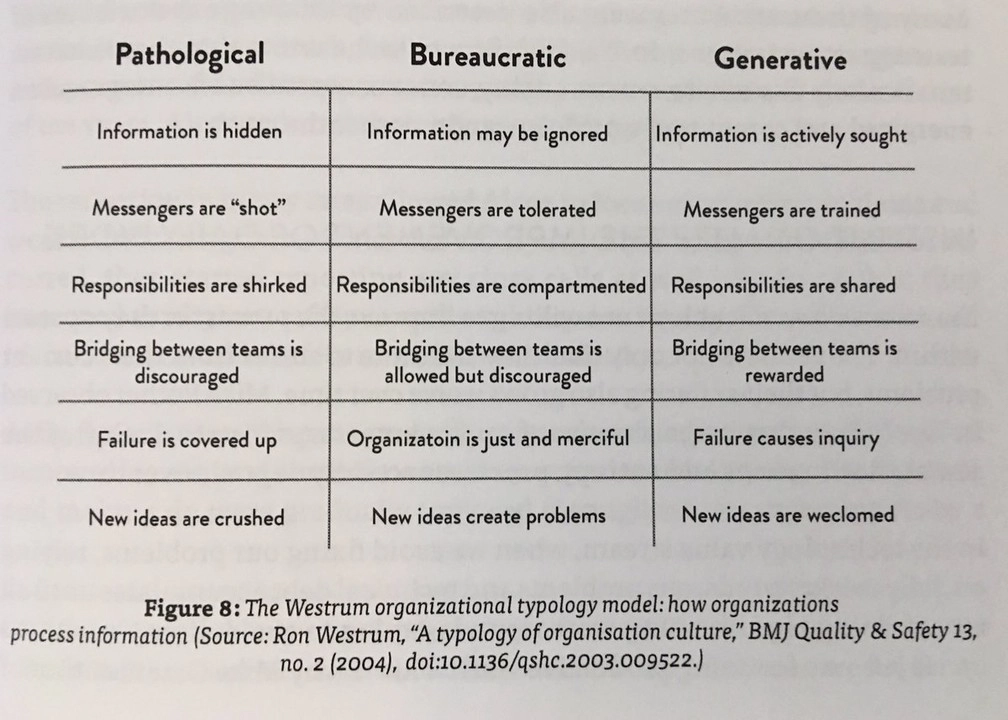Visionary Digital Evolution Strategist
Rooted in Formula 1 excellence, with over 30 years in IT starting as a child in the 1980s, …

Welcome back, my fellow digital warriors! ⚔️
In our last episode, we uncovered the Volkswagen Group’s colossal missteps, where they failed to treat software as the core foundation of their business. Instead, it was relegated to just another cost center—a mindset that led to heavy layoffs, drastic budget cuts, and desperate, last-minute billion-dollar partnerships to buy skills and mindsets they lacked. The result? A staggering loss of over €20 billion in just four years, a perfect case study in how digital transformation (DX) can spiral out of control.
This sparked a major conversation about why so many digital transformations fail. Is it poor planning? A lack of foresight? Or is there something deeper at play? Buckle up, because we’re diving deep into the drama, unpacking the common pitfalls of DX and why failure is more common than success.
Imagine your company is a clunky old machine – like trying to run the latest video game on a PC from 2005. That’s what many businesses feel like when they realize the world is moving at the speed of light, but they’re stuck with slow processes, outdated tech, and labor force with skills from the Stone Age. Enter Digital Transformation or DX, the market promise to making everything smarter, faster, and smoother.
Digital transformation is all about integrating cutting-edge tech – from AI and cloud computing to automation and IoT – into every nook and cranny of a business. It’s not just about upgrading systems or buying the latest software; it’s about:
rethinking how your business operates in this fast-paced, digital world.
It’s like a corporate makeover but for your company’s brain. The goal? To get stuff done faster, better, and cheaper – while making your competition sweat.
You know what they say: Go big or go home. And companies are certainly going big on digital transformation. By 2027, spending on DX is expected to hit almost $4 trillion globally. That’s a lot of dough! For context, that’s more than the GDP of some countries. Businesses, from manufacturing giants to your local grocery store chain, are dropping serious cash on AI, cloud systems, automation tools, and all the other buzzwords you hear at tech conferences.
In fact, 91% of businesses have already jumped on the DX bandwagon. And while the pandemic may have made us rethink many things (like working in our pajamas), it definitely kicked DX plans into high gear. Companies that once thought, “Eh, maybe next year,” realized that “next year” is now or never.
Now here’s the kicker: Despite all the cash and hype, digital transformation is more like a risky poker game than a sure bet. Brace yourself – a staggering 84% of digital transformations fail, and the 75% of the remaining report only mediocre performance.
Only 7% of DX are a success story. 😱
That’s right, the majority of companies that pour millions (sometimes billion) into digital overhauls don’t see the ROI they were hoping for. It’s like throwing a party and no one shows up. A drama of $2.3trillion wasted Globally in Failed Digital Transformation.
Why? It’s not just about bad luck. Companies often overestimate what DX can do for them, or they get bogged down in complex strategies that don’t align with their actual needs. It’s like trying to use a Lamborghini for grocery shopping – sure, it’s fast, but is it really what you need for that quick ‘get some bread’ kinda run?
According to the data, businesses expect DX to give them a huge boost in revenue – but they typically capture only 31% of that revenue lift. And when it comes to saving costs? Forget it. They only save 25% of what they hoped. It’s no wonder some companies feel like they’ve been sold magic beans instead of a beanstalk to success.
Great question! There’s a bunch of reasons, but here are the biggies I observed in over 2 decades of doing them from the trenches 🪖.
One of the biggest roadblocks in digital transformation is not just about the technology—it’s about people. Many companies are stuck with traditional leadership and legacy cultures where innovation goes to die. As Prof. R. Westrum outlined in his “Typology of Organizational Cultures”, non-generative or pathological environments often foster resistance to change, stifle collaboration, and drive away talented individuals. In these environments, psychological safety is low, and employees are less willing to experiment, share ideas, or engage in meaningful change.
Without a generative culture, where people feel safe to innovate and fail, DX initiatives will struggle. It’s in these non-generative settings that top talent jumps ship while others resist change, leaving the company ill-equipped to handle the evolving digital landscape.

The problem often starts in the boardrooms, where high-stakes consultants are hired to lead the DX without truly understanding the cultural shift required. Senior leaders mistakenly believe the consultants will “do the work” for them. When the transformation fails, it’s these same leaders who are often the cause, as they resist the fundamental cultural changes needed to drive success. Meanwhile, the consultants cash out, leaving behind a fresh coat of paint and an invoice with six zeros.
A common pitfall in digital transformation (DX) is the disconnect between high-level business objectives and tactical, day-to-day execution. Many companies dive into DX with a vague vision of becoming more competitive by leveraging new technology, but without a clear, ‘actionable blueprint’. In boardrooms, this vision is often expressed in financial terms—growth targets, revenue goals, and market share increases. The problem? These financial objectives rarely trickle down effectively to the teams responsible for executing the plan.
This lack of translation between economic objectives and tactical goals leads to confusion, rework, and wasted effort. Teams are left without clear, measurable day-to-day objectives, causing them to lose sight of how their work ties into the broader business vision. Without concrete steps to get there, these high-level ambitions are just dreams.
Furthermore, when financial indicators are the sole focus, there’s a strong temptation for middle management and C-level executives to chase them at any cost. This often leads to short-sighted decisions like cost-cutting as the go-to solution to meet boardroom expectations, which can backfire disastrously. It’s a classic case of prioritizing the “low-hanging fruit,” but this approach will cripple long-term success—just look at the Boeing 737-MAX story, where aggressive cost-cutting compromised safety and led to catastrophic results.
In trying to meet financial goals quickly, organizations inevitably set themselves up for digital transformation failure, sacrificing long-term growth for short-term gains.
One of the biggest mistakes companies make is underestimating the long-term and iterative nature of digital transformation (DX). They treat it as a quick fix rather than the continuous, evolutionary process it truly is. This misconception was a major factor in the downfall of projects like Volkswagen’s Cariad software division, where the sheer complexity of the DX initiatives was grossly misjudged. Boards often fail to account for the time and scope it takes for an organization to truly evolve into a new, digitally enhanced entity.
What I’ve noticed with many board members over the years is the subtle yet dangerous shift in how they talk about transformation. For most, it’s not about evolving their company into an improved version of itself. Instead, it’s seen as a one-off transformation, simply upgrading from the old to the new by leveraging technology and handing over responsibility to high-stakes consultants. This mindset is incredibly risky because it outsources ownership of the transformation, making executives believe that someone else will execute a complete overhaul—like hiring a contractor to renovate your house before the summer.
But DX isn’t a straightforward project. It’s a holistic evolution of every aspect of your business. From product lines to back-office functions like HR, procurement, and legal, every department must adapt to the new digital landscape. And because each company has a unique nature, you can’t use a cookie-cutter approach to transformation. It’s a long, intricate journey that requires deep, continuous involvement.
The Volkswagen Cariad disaster is a perfect cautionary tale. The lesson?
DX isn’t just a technology upgrade—it’s a company-wide evolution that requires sustained focus and commitment.
Big consultancies like McKinsey, Accenture, or Deloitte often roll out DX playbooks, but without a strong change management plan, the transformation crumbles. Employees need to feel empowered and part of the mission, not alienated by top-down mandates
Change management isn’t just about communication; it’s about guiding people through the entire transformation journey. In the absence of a structured approach, employees may feel lost or threatened by the evolving processes. A lack of change management is often compounded by misaligned priorities at the leadership level. When boards are laser-focused on financial targets or cost-cutting, they may neglect the human side of transformation, assuming that employees will simply adapt to new technologies without guidance. However, without proper up-skilling, support, and a continuous active-learning framework like a dojo that encourages growth and experimentation, the transformation is bound to face internal resistance and sure failure.
To succeed in digital transformation, it’s essential to recognize that technology alone isn’t enough. A true transformation requires evolving both the social and technical systems within an organization. As Eric Trist and R. Westrum have both shown through their work on socio-technical systems, organizations function best when their technological advancements are paired with an equally robust evolution of social structures—how people interact, collaborate, and adapt.
One of the most significant reasons for digital transformation (DX) failure is underestimating the true cost involved. Many companies treat DX like a one-time expense, hoping to quickly upgrade their technology and processes. However, DX is more like a marathon than a sprint, requiring ongoing investment in both technology and people. Without proper financial planning, companies are caught off guard by the hidden costs that emerge—delays, technical debt, and skyrocketing expenses as the transformation drags on.
A key misconception is that DX will immediately free up resources, reduce waste, and boost performance. However, in reality, cookie-cutter approaches to transformation often create the opposite effect. Instead of improving efficiency, these ill-prepared strategies tend to slow down performance, increasing costs as companies grapple with the complexity of integrating new technologies while keeping day-to-day operations running.
–
The Silver Lining But hey, it’s not all doom and gloom. When DX hits the mark, it’s a game-changer. Companies that get it right create up to more value, improve efficiency, and meet goals faster than those who fail. In other words, if you get DX right, you’ll be crushing your competition.
The key?
Think of DX like a marathon, not a sprint. You’ve got to set the finish line, do just a little plan, allocate money for the long run, prioritize people up-skilling, and make sure the humans – not just the machines – are ready to run the race.
So, if you’re feeling a little nervous about starting or continuing your digital transformation journey, you’re not alone. Over the next few articles, I’ll dive deeper into these five pitfalls and offer actionable insights on how to navigate around them leveraging the research made with the Unicorns’ Ecosystem.
⏭️ Stay tuned. It’s time to turn this transformation from a disaster waiting to happen into an evolution that brings real value.
To stay in the loop with all our updates, be sure to subscribe to our newsletter 📩 and podcast channels 🎧:
🎥 YouTube
📻 Spotify
Visionary Digital Evolution Strategist
Rooted in Formula 1 excellence, with over 30 years in IT starting as a child in the 1980s, …